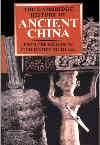
The Cambridge History of Ancient China:
From the Origins of Civilization to 221BC
© Cambridge University Press 1999, ISBN 9780521470308
Archaeology. The Environment of Ancient China
by David N. Keightley, University of California, Berkeley

Links
Posting Introduction
A brief review of the Kurgan people culture see on page 1 “Zhou Culture”. This page reviews the climate, a major driving force for the nomadic Kurgan people.
* * *.
The posting's notes and explanations, added to the text of the author and not noted specially, are shown in (blue italics) in parentheses and in blue boxes. Footnotes, mostly on the sources, are not posted, with minor exceptions where footnote explanations area part of the narrative. Square brackets replace omitted Chinese transcriptions in the text.
University of California, Berkeley
The Environment of Ancient China (18,000 - 221 BC)
Climate and Environment
30
Many aspects of early Chinese history were affected, if not determined, by the Neolithic and Bronze Age environment, whose evolving climate and landscape influenced a series of cultural decisions at the regional level, involving such matters as hunting, diet, health, housing, clothing, exchange, and the development of agriculture. Reconstruction of the early environment provides fresh ways to understand the origins and character of ancient Chinese civilization.
GEOGRAPHY
The Coastline
During the drier and colder period of the Last Glacial Maximum (ca. 18,000—15,000 BC),
the sea level had fallen radically, exposing much of the continental shelf of East China,
so that the coast lay anywhere from 200 to 1,000 km to the east of its present location,
with Japan, Taiwan, and Hainan Island all linked to the mainland. Following the end of
the glaciation (ca. 13,000 BC), however, the sea level rose rapidly. In North China, it
reached, with occasional fluctuations, its highest point between 4,000 and 3,000 BC, when
it was 5-10 m higher than at present; in the Yangzi [][ delta, by contrast, the maximum
transgression had, due to local tectonic movements, taken place ca. 5,500 BC. After
further fluctuations, the coastline came to approximate its present position toward the
end of the Former Han dynasty in AD 9. 1
31
The changes in sea level affected the habitation sites and subsistence patterns of a large number of Neolithic coastal cultures. To the northeast, the Liaodong shore experienced marine transgressions that, ca. 2,000—1,000 B.C., appear to have forced the Neolithic coastal inhabitants to move inland to higher ground.2 Further south, the Bo Hai [] coastline, ca. 5,000-4,000 BC, lay as much as 100 km west of its present location, with many large lakes, some linked to the sea, forming in the depressed area, which is still filled with lakes and marshes, some 110 krn south of modern Beijing. 3 The coastline to the south of Shandong also experienced periods of marine transgression and regression. 4
Still further to the south, much of the land around Hangzhou Bay (Hangzhou wan [])
emerged from the sea after 5,000 BC to form a plain filled with numerous lakes; notable
Neolithic sites, like those of Songxe [] and Jiaxing [], appear to have been located on
what had once been a large island, with the mainland coast lying some distance to the
west in the vicinity of modern Hangzhou. The waters of Lake Tai (Tai hu []) connected at
many places with the sea and reflected, accordingly, the changes in sea level, with the
period from 3,000 to 2,500 BC witnessing the greatest spread of the lakes and marshes.
5 ...
33
Initial reconstructions - based upon palynological (spores and pollen) and archaeological evidence - generally tell confirming stories of a paleoclimate that after the coldness and dryness of the last glacial maximum, gradually grew warmer and wetter, with the period from ca. 6,000 to 1,000 BC being the warmest and wettest in the last 18,000 years. It is no coincidence that the inhabitants of Neolithic China were able to expand their settlement range and develop their cultures during this Holocene Climatic Optimum (ca. 7,500-3,000 BC). After that period, the climate underwent, with fluctuations, a gradual drying and cooling that, consistent with changes in the contemporary global climate, has continued until modern times. 13 The environmental history of the Late Holocene in China involves the gradual southward retreat of the subtropical flora and fauna that had flourished in north China in earlier times.
In the northeast, for example, palynological
studies in southern Liaoning indicate that between ca. 8,300 and 6,000 BC, the climate
had been both drier and colder, by some 6°C, than it is today; the forests were mainly
of birch, with some elm, oak, and pine. The climate grew considerably warmer by ca. 6,000
to 5,000 BC, with oak and alder abundant in the forests, birch decreasing, and pine increasing.
14 In the period that followed (ca. 3,000-1,000
BC), however, mean annual temperature fell and remained relatively constant, standing at
2-4°C warmer than it is today. After approximately 1,000 BC a further fall in
temperature, gradual and prolonged, began. 15
34
In the Central Plain, at ca. 6,000 BC, the climate, in the last stages of the Postglacial Climatic Optimum, had also grown wetter and warmer; more oaks appeared in the forest, several varieties of evergreen tree and brake fern were present. The remains of herbivores, like cattle, deer, and sheep, in Peiligang [] Neolithic sites indicate the presence of extensive grasslands; and the remains of numerous aquatic animals, like fish, alligators, freshwater mussels, and snails, together with marshy sediments, reveal the widespread existence of rivers, lakes, and marshes. 16 Most of the fauna were those of the temperate zone, indicating that the climate generally resembled that of the present day. During the Yangshao stage (ca. 5,000-3,000 BC), the presence of carnivores, like the tiger, black bear, and leopard, indicate a hinterland of mountains and forests, and the presence of the Giant Panda, the bamboo rat, and abundant traces of bamboo further indicate an environment in which bamboo flourished. The remains of subtropical animals like the Sumatran rhinoceros, Asian elephant. Macaque monkey, musk deer, jackal, and peacock - animals that today are generally found to the south of the Qinling Mountains, in the Yangzi Valley, or still further south - further reveal that the climate was warmer than it had been earlier. The existence of a climatic optimum at this time is also supported by reconstructions from Beijing, Shanghai, and Taiwan. 17
From ca. 4,000 to 3,000 BC, however, the climate in the Henan region gradually turned
cooler and drier, as indicated by the disappearance of the tropical and subtropical animals, by the smaller number of aquatic
animals, and by the predominance of yellow aeolian soil
(wind-transported sand grains, dunes) in the deposits. The change in the
climate, however, was gradual and gentle. By the Longshan [] period ca. 3,000-2,000 BC), the remains of herbivores like horse, cattle, sheep, and deer indicate the continuing presence of
abundant water, grass, and dense forests; and the presence of a small number of southern
deer suggests that the temperature may still have been warmer than it is today.
18 Similar
evidence reveals that the Yangxi Valley was also generally warmer and wetter in the
middle Holocene than it is at present, with mangrove forests, which are now found only on
the South China coast, growing in the coastal areas. 19
35
Just as the shifts in the coastline and the course of the Yellow River had influenced settlement patterns, so did these changes in climate. The reduction in the size of the lakes and marshes, whose presence in the earlier period had rendered the low-lying areas less hospitable to the Yangshao inhabitants, evidently rendered more land habitable and may have contributed to a marked increase in the size of the Longshan population and the density of its settlements in various regions. 20
When we come to the Bronze Age, the
archaeological evidence provides further indication of a cooling trend in Henan, as
temperate-zone animals, like horse and cattle, increasingly replaced the subtropical
fauna that are now found only to the south. 21 In the Wei
[] River valley, pollen samples
from ca. 1,000 BC also indicate that during the early years of the Western Zhou, the
climate was growing colder and drier. 22 Historical texts confirm this trend. The
Zhushu jinian []: (Bamboo annals), for example, records that at various times in the
mid-Western Zhou, the Han [] and Yangzi Rivers froze, that there was a major drought, and
that the Jing [], Wei, and Luo [] Rivers all ran dry. 23 Although Zhou temperatures were
still generally warmer than those known today - as indicated by references to a lack of
ice in winter, the presence of bamboo and plum in north China, and the possibility of
double cropping in the regions of southern Hebei and southern Shandong - the general
trend was one of increasing coolness and aridity.24
36
The landscape itself, whether dominated by temperate, subtropical, or tropical forest, would, in the earlier periods, have been far more densely wooded and covered with brush and other vegetation than it is today. 25 Early farmers would have had to clear such cover before they could grow their crops; they would also have had to confront the numerous wild animals that took such forest and brush for their habitat, preying upon both man and his crops. The denudation of the Chinese landscape, so notable a feature of modern China, was only beginning in the ancient period. 26
The general conclusion to be drawn from the evidence, both archaeological and textual, is that the rainfall in Neolithic and early Bronze Age China would have extended further north and for longer periods than it does today, and that the climate, with fluctuations, was more temperate and hospitable than it was to be in imperial and modern times, thus providing for a longer growing season. The different regional environments help to explain the various adaptational strategies adopted by the emerging Neolithic cultures when, for example, they chose to focus their food-gathering and early agricultural efforts on millet, or rice, or other aquatic plants. The benevolence of the climate and the fecundity of the environment also help to explain the increasing prosperity of the Neolithic and Bronze Age cultures that were emerging in China at this time. And it is not implausible to suppose that such a favorable environment also contributed to the general optimism about the human condition and human nature that characterizes much early Chinese religion, legend, and philosophy.
26 Wang Shihe et al. (“Anban yizhi baofen fenxi”, p. 64) conclude that Chinese farmers began to have a significant impact on the environment at the start of the Western Zhou, ca. 1000 BC.